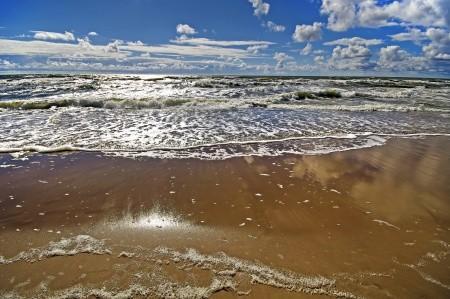If your holiday plans for Canada Day or July 4th long weekend involve a trip to the beach, you need to take note of a new report by the U.S. Environmental Protection Agency, which found that ten percent of water samples taken from U.S. coastal and lake beaches fail to meet safety standards.
Steve Fleischli, water program director for the Natural Resources Defense Council said,
“There can be hidden dangers lurking in many of our waterways in the form of bacteria and viruses that can cause a great inventory of illnesses like dysentery, hepatitis, stomach flu, infections and rashes.”
The report is based on nearly 500 samples taken annually at beaches around the country. They found Great Lakes beaches have the highest failure rate with major bacterial content.
The agency said that the findings prove that water pollution due to storm water runoff and sewage overflows were persistent in the US.
Storm-water runoff often includes trash, chemicals, oil and animal and human waste as well as bacteria and viruses.
“It’s really all of our urban slobber going untreated into local waterways,” Fleischli said.
On the brighter side, the agency did give star points to 35 popular beaches for their superb water quality.
These beaches met national water quality standards 98 percent of the time over the past five years.
They include:
- Delaware: Dewey Beach-Swedes in Sussex County
- Florida: Bowman’s Beach in Lee County
- Georgia: Tybee Island North in Chatham County
- Massachusetts: Singing Beach in Essex County
- New Jersey: Stone Harbor at 96th St. in Cape May County
The 17 “repeat offenders” that continue to have serious water pollution problems include:
- California: Malibu Pier, 50 yards East of the pier, in Los Angeles County
- Indiana: Jeorse Park Beach in Lake County
- Massachusetts: Cockle Cove Creek in Barnstable County
- Maine: Goodies Beach in Knox County
- New Jersey: Beachwood Beach in Ocean County
- New York: Main Street Beach in Chautauqua County
Comparatively, 13 percent of the samples from the Great Lakes failed to meet the standard. Other beaches where the swimming water was found to be highly contaminated include, the Gulf Coast (12 percent), New England (11 percent), the western coast (9 percent), New York and New Jersey coasts (7 percent), and the southeast (7 percent).
States with the highest failure rates include: Ohio (35 percent), Alaska (24 percent) and Mississippi (21 percent).
At Delmarva Peninsula area on the East Coast, only 4 percent of the samples failed the test, making these waters safe for swimming.
Three states had a failure rate of just 3 percent: Delaware, New Hampshire and New Jersey, the researchers found.
The EPA has found that approximately 3.5 million Americans fall sick due to contact with raw sewage overflows each year.
“The elderly and little kids are most likely to fall prey to contamination in the water because of their weaker immune systems,” Fleischli said.
“Children are also more likely to dunk their heads under the water or swallow water when swimming, both of which increase risk,” he added.
Historically the largest source of beach water pollution has been the storm runoff. More than 10 trillion gallons of untreated storm water, including billions of gallons of untreated sewage, find their way into America’s waterways each year, according to the EPA.
Beaches are required to be tested under the federal Beaches Environmental Assessment and Coastal Health (BEACH) Act for bacteria. If the bacteria level is too high, especially after heavy rain, beaches may be closed or people advised not to swim.
The best way to safeguard beaches the council said is to invest in “smarter, greener infrastructure on land, like porous pavement, green roofs, parks, roadside plantings and rain barrels.”
The simple alterations help rain to evaporate or filter into the ground instead of being carried from dirty streets to beaches.

